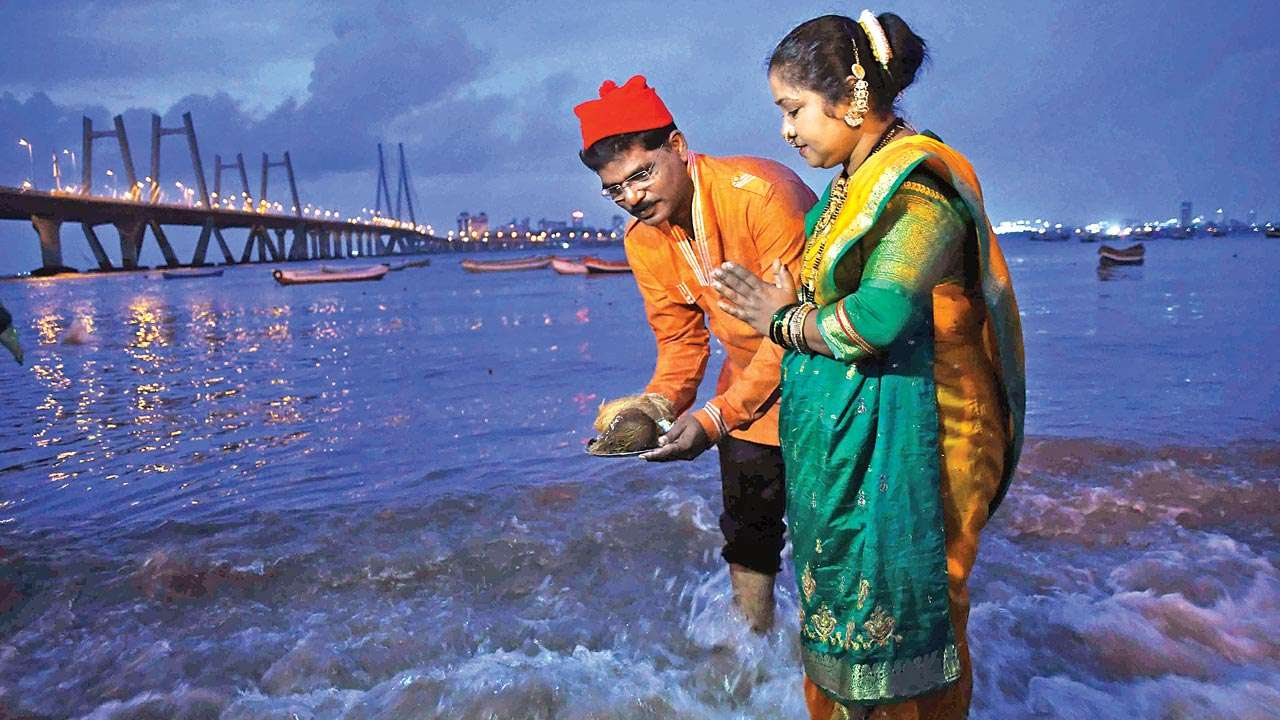Narali Pournima
In the month of Shravan, the full moon day is celebrated in different parts of Maharashtra and is known as Narali Pournima. During the monsoon, the sea is unsafe for fishing, and hence fishermen do not venture into the sea. Narali Pournima marks the end of the monsoon and the beginning of the new fishing season and fishermen appease the sea god before sailing out in their beautifully decorated boats.
‘Naral’ means ‘coconut’, and ‘Pournmia’ is the full-moon day when offerings of coconuts are made to the sea god on this day. The fisher-folk make offer coconuts and prayers to the sea-god and seek his blessings to prevent any untoward incidents, as they begin the fishing season. Sweets made from coconut are savoured on this day. Narali Pournima also coincides with the festival of Raksha Bandhan, when brothers vow to protect their sisters and the sisters tie a thread on their brother’s wrist as a sign of respect and affection.
Nārali Poornima is a ceremonial day observed by Hindu fishing communities in Maharashtra, India particularly around Mumbai and the Konkan coast. It is held on the full-moon day of the Hindu month of Shravan which falls around July or August. On this day offerings such as rice, flowers and coconuts as offered to Lord Varuna, the god of ocean and waters. Another ceremony involves women tying a rakhi or amulet on the wrists of their brothers.
Raksha Bandhan is a popular and traditionally Hindu annual rite or ceremony that is central to a festival of the same name celebrated in the Indian Subcontinent. It is also celebrated in other parts of the world significantly influenced by Hindu culture. On this day, sisters of all ages tie a talisman or amulet called the Rakhi around the wrists of their brothers. They symbolically protect them, receive a gift in return, and traditionally invest the brothers with a share of the responsibility of their potential care.
Raksha Bandhan is observed on the last day of the Hindu lunar calendar month of Shraavana, which typically falls in August. The expression "Raksha Bandhan" (Sanskrit, literally "the bond of protection, obligation, or care") is now principally applied to this ritual. Until the mid-20th century, the expression was more commonly applied to a similar ritual, held on the same day, with precedence in ancient Hindu texts. In that ritual, a domestic priest ties amulets, charms, or threads on the wrists of his patrons, or changes their sacred thread, and receives gifts of money. This is still the case in some places. By contrast, the sister-brother festival, with origins in folk culture, had names which varied with location. Some were rendered as Saluno, Silono,and Rakri. A ritual associated with Saluno included the sisters placing shoots of barley behind the ears of their brothers.
Of special significance to married women, Raksha Bandhan is rooted in the practice of territorial or village exogamy. The bride marries out of her natal village or town, and her parents by custom do not visit her in her married home. In rural north India, where village exogamy is strongly prevalent, large numbers of married Hindu women travel back to their parents' homes every year for the ceremony. Their brothers, who typically live with their parents or nearby, sometimes travel to their sisters' married home to escort them back. Many younger married women arrive a few weeks earlier at their natal homes and stay until the ceremony. The brothers serve as lifelong intermediaries between their sisters' married and parental homes, as well as potential stewards of their security.
In urban India, where families are increasingly nuclear, the festival has become more symbolic but continues to be highly popular. The rituals associated with this festival have spread beyond their traditional regions and have been transformed through technology and migration. Other factors that have played a role are: the movies, social interaction, and promotion by politicized Hinduism, as well as by the nation state. Among women and men who are not blood relatives, there is a transformed tradition of voluntary kin relations achieved through the tying of rakhi amulets. This has cut across caste and class lines and Hindu and Muslim divisions.In some communities or contexts, other figures such as a matriarch or a person in authority can be included in the ceremony in ritual acknowledgement of their benefaction.




Comments
Post a Comment